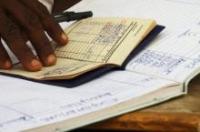Tracking finance is needed to inform policies and decision making and to target investments in water and sanitation
Published on: 23/12/2015
To reach universal access to safe drinking water and sanitation, we need to know how much finance is needed and who needs to contribute with what. The World Bank (2016) estimates that achieving universal access by 2030 will cost between US$ 14 and US$ 47 billion per year. This only includes the costs to extend WASH services to the unserved, not even to maintain the systems. We will not reach universal coverage by 2030 with present investment and growth rates. For new infrastructure alone, current investment levels need to triple.[1]
Monitoring investments in the WASH sector in low- income countries is currently very limited
Monitoring investments in the WASH sector in low-income countries is currently very limited. The vast majority of the countries surveyed for the UN-Water GLAAS report of 2014 had no comprehensive process in place to track funding. There is little knowledge regarding how much is allocated by governments and donors and even less on how much households are contributing towards the construction or maintenance of the infrastructure. Many governments are unable to determine whether funding is reaching areas of greatest need and whether they are meeting funding allocation targets, such as the eThekwini declaration and the SWA-High Level Panel commitments. As financial data are often non-existent or not accessible, financial accountability to customers is poor (see WIN 2016) . These issues can be addressed by tracking financial flows.
Tracking of finance can help to improve value for money, provide costs and financing benchmarks, and assist in better utilisation of existing funds. It can enable the sector to address problems related to absorptive capacity, the lack of asset management, and the lack of clarity on how to fund recurrent costs. It furthermore helps to target and shift financial resources to those who most need WASH services. Making financial information available also enhances the transparency of financial flows to the sector. This is a must because it decreases opportunities for corruption and illicit financial flows. Making the financial data available to citizens bridges the current financial accountability gap in the water and sanitation sector.

In the WASH sector there are currently three methodologies for tracking finance:
Tracking finance also means knowing where the money for sector-related activities is coming from. The main financing sources to recover the costs of water, sanitation and hygiene service delivery are usually a combination of the three T’s: taxes levied by national or regional governments, transfers made by development partners, and tariffs (or own contributions) paid by users. For more info on these financing sources have a look at OECD 2009.
Tracking finance is not easy. There are many different funding flows in a country and many different definitions of service levels and unit costs. This makes it hard to have national or even district overviews that can indeed inform national- and district-level decision making. Most governments and donors also struggle to submit disaggregated financial data, and little is reported on recurrent expenditures.
Although an important first step, tracking financing flows tells little about the actual services being provided to the population. The expenditure for WASH is not in itself an indicator of the effectiveness, efficiency, or sustainability of investments.[2] Neither does tracking finance necessarily impact decision making. It does make the invisible financial data visible. IRC believes that small-scale action research involving those who need to know is a good start in setting up financial monitoring systems. That is what IRC is doing in its focus countries. Have a look at the documents below to see some examples.
Introduction:
Methodologies:
Examples from around the world:
Background info:
For more information about this topic you can also have a look at the Akvopedia Finance portal.